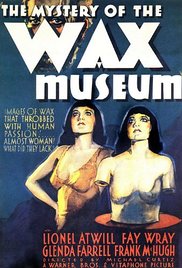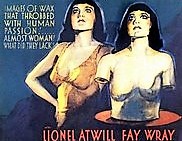Mystery of the Wax Museum **** (1933, Lionel Atwill, Fay Wray, Glenda Farrell, Frank McHugh) – Classic Movie Review 5,024
The gruesomely atmospheric 1933 horror film Mystery of the Wax Museum stars Lionel Atwill as Ivan Igor, the scarred museum owner with human wax-covered models. The beautiful restoration of the two-colour Technicolor film reveals it as a work of art.
‘Women of FLESH become WAX in his hands… women of wax become flesh!’
Director Michael Curtiz’s 1933 classic horror movie Mystery of the Wax Museum is a gruesomely atmospheric picture, with Lionel Atwill starring as Ivan Igor, the scarred museum owner with human wax-covered models, and Glenda Farrell co-starring as Florence Dempsey, the about-to-be-fired newswoman who tries to get a scoop and stop his rampaging. Her editor Jim (Frank McHugh) is giving her a hard time.
Atwill is clearly enjoying himself in an enjoyably ripe performance, Glenda Farrell has a lot of spirited eager-beaver reporter stuff to do, and the film provides another splendid chance for King Kong’s Fay Wray to give a workout to her screaming again when her character Charlotte Duncan finds Ivan Igor’s ghastly face and he wants to turn her into one of his wax figures, by chucking her into a vat of wax and preserving her beauty for ever.
Produced and released by Warner Bros, it is filmed in gloriously beautiful two-colour Technicolor. Sadly, though excitingly here, Mystery of the Wax Museum and its predecessor the 1932 Doctor X, also with Lionel Atwill and Fay Wray, were the last two drama films using this process. Technicolor founder Herbert Kalmus said the film was ‘the ultimate that is possible with two components’.
The screenplay by Don Mullaly and Carl Erickson is based on a short story and play by Charles S Belden. The rather odd mix of horror story and murder mystery works a treat. It is beautifully shot by Ray Rennahan, with inventive, fluid camerawork, and the lovely use of two-tone Technicolor gives it an enormous lift. Warner Bros present an exceptionally fine production with incredibly handsome sets by inspired production designer Anton Grot. Along with Atwill and Farrell, these are the stars of the film. Every single frame of the film could be hung in an art gallery to the greatest of acclaim.
Also in the cast are Frank McHugh, Gavin Gordon, Allen Vincent, Edwin Maxwell, Holmes Herbert, Claude King, Arthur Edmund Carewe, Thomas E Jackson, DeWitt Jennings, Matthew Betz, and Monica Bannister.
It is a follow-up to Doctor X, involving many of the same cast, including Lionel Atwill, Fay Wray, Arthur Edmund Carewe, and Thomas Jackson, and crew, director Michael Curtiz, art director Anton Grot and cameraman Ray Rennahan. Iteven re-uses Doctor X’s opening theme music by Bernhard Kaun.
Remakes: House of Wax (1953) with Vincent Price and House of Wax (2005) with Chad Michael Murrray.
And don’t forget Charlie Chan at the Wax Museum.
The film is based on the unpublished short story The Wax Works by Charles S Belden, who had also written a play called The Wax Museum.
Supposedly, many of the statues in the film were played by actors because the heat generated by the extremely bright lights required for the two-colour Technicolor process could melt wax.
Warner Bros had a falling-out with Technicolor after the studio violated their contract by filming Doctor X with an additional black-and-white unit, permitting them to process black and white prints at their own lab and avoid paying Technicolor thousands of dollars. But, when Technicolor’s three-strip process became available, Warner Bros was the first to use it for live-action shorts, beginning with Service With a Smile (1934).
Warner Bros kept the negatives for their two-colour cartoons, but not their live-action projects, and over time it came to be considered a lost film.
But the nitrate print of the film from former studio head Jack Warner’s personal collection was found in 1970 and now resides at UCLA, which also holds a French workprint. In 2019, The Film Foundation sponsored an absolutely beautiful digital 4K restoration of the film by the UCLA Film & Television Archive, with funding from the George Lucas Family Foundation. After all the patient, painstaking work, it reveals Mystery of the Wax Museum as a work of art.
Mystery of the Wax Museum is directed by Michael Curtiz, runs 77 minutes, is produced and released by Warner Bros, is written by Don Mullaly and Carl Erickson, based on The Wax Works by Charles S Belden, is produced by Henry Blanke and Hal B Wallis, is shot by Ray Rennahan, and scored by Cliff Hess.
It was released on February 18, 1933 (US).
It was a hit. The film cost $279,000 to make and made a profit of $80,000, earning $325,000 in the US and $781,000 internationally.
The cast are Lionel Atwill as Ivan Igor, Fay Wray as Charlotte Duncan, Glenda Farrell as Florence Dempsey, Frank McHugh as editor Jim, Allen Vincent as Ralph Burton, Gavin Gordon as George Winton, Edwin Maxwell as Joe Worth, Holmes Herbert as Dr Rasmussen, Claude King as Mr. Galatalin, Arthur Edmund Carewe as Sparrow/ Professor Darcy, Thomas Jackson as detective at the morgue, DeWitt Jennings as police captain, Matthew Betz as Hugo, Monica Bannister as Joan Gale, James Donlan as senior morgue attendant, William Wagner as junior morgue attendant, Lon Poff as Worth’s henchman, Robert Emmett O’Connor as Joe the police officer, Frank Darien as the autopsy surgeon, Wallis Clark as the medical examiner, Bull Anderson as janitor Otto, Walter Percival as Winton’s attorney, William B Davidson as detective, Guy Usher as detective, and Robert Homans as desk sergeant.
© Derek Winnert 2017 Classic Movie Review 5,024
Check out more reviews on http://derekwinnert.com



